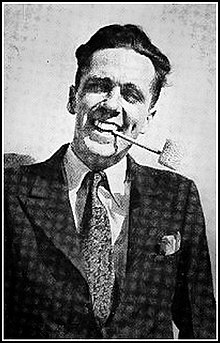John Patric | |
|---|---|
 John Patric during his college days | |
| Born | John Patric May 22, 1902 Snohomish, Washington, US |
| Died | August 31, 1985 (aged 83) Everett, Washington, US |
| Resting place | Grand Army of the Republic Cemetery, Snohomish, Washington |
| Pen name | Hugo N. Frye, Simon Legree |
| Nickname | Pat |
| Occupation | Journalist, writer |
| Language | American English |
| Alma mater | |
| Period | 1930–1945 |
| Genre | Non-fiction |
| Subject | Travel, consumer protection |
| Notable works | Yankee Hobo in the Orient |
| Signature | |
 | |
John Patric (May 22, 1902[1] – August 31, 1985[2]) was an American writer. He was a contributing writer for National Geographic during the mid- to late 1930s and early 1940s[3] and was the author of two books. His 1943 book, Yankee Hobo in the Orient, sold twelve million copies domestically and internationally in both hardcover and digest format.[4] In the 1940s, he was one of the best-known Oregon writers.[5]
He wrote a National Geographic feature article, Imperial Rome Reborn, about fascist Italy,[6] and after writing on World War II shipyard labor practices for Reader's Digest, he gave testimony at a United States congressional hearing.[7] Patric or his works are briefly mentioned by other writers on a diverse range of topics, including political history,[8] an artist biography,[9] an author biography,[10] media history,[11] cultural criticism,[6] ship building,[7] fascism,[12] and Korean history.[13]
In later life, Patric was an early influence on portrait artist Chuck Close,[9] and a perennial political activist and satirical political candidate in his home state of Washington.[14] Clayton Fox of The Olympian described Patric using phrases like, "the bearded bard of Snohomish", "gadfly of golliwoggs and gooser of governmental gophers," and "the pricker of political stuffed shirts, scourge of junkmailers, implacable foe of pollution and corruption, aider and abetter of bees, trees and ocean breezes".
- ^ "Birth Return: John Patric". Washington State Digital Archives.
- ^ "John "Hugo Frye" Patric". ElectionsInfo.net.
- ^ "John Patric". NationalGeographic.com. National Geographic. Retrieved March 25, 2015.[dead link]
- ^ Patric, John (1945). "Foreword". Yankee Hobo in the Orient (8th ed.). Florence, OR. LCCN 47003382. OCLC 2044145.
{{cite book}}: CS1 maint: location missing publisher (link) - ^ Allen, Eric W. (June 13, 1943). "Patric Of 'Flying Pan Creek' Writes on Japan's Strength". Eugene Register-Guard. Retrieved March 24, 2015.
- ^ a b Collins, Jane; Lutz, Catherine (1994). "Becoming America's Lens on the World: National Geographic in the Twentieth Century". In Torgovnick, Marianna (ed.). Eloquent Obsessions: Writing Cultural Criticism. Duke University Press. p. 144. ISBN 978-0-8223-1472-1.
John Patric's coverage of Mussolini's Italy, also from the late 1930s, shows the sinister side of a commitment to present 'only what is of a kindly nature.' Even the Society's quasi-official history represents the early coverage of World War II as a somewhat curious overextension of tact and nonpartisanship: John Patric's March 1937 'Imperial Rome Reborn' celebrated Italy's new glories, but the photographs were chilling: ...
- ^ a b "Production in Shipbuilding Plants: Executive Hearings Before the Committee on the Merchant Marine and Fisheries, House of Representatives, Seventy-eighth Congress, First Session, on H.Res. 52, a Resolution Authorizing Investigation of the National Defense Program as it Relates to the Committee". U.S. Government Printing Office. 1943. pp. 847, 1105, 1140.
- ^ Dobbs, Ricky F. (2005). Yellow Dogs and Republicans: Allan Shivers and Texas Two-Party Politics. Texas A&M University Press. p. 12. ISBN 978-1-58544-407-6.
- ^ a b Finch, Christopher (2010). Chuck Close: Life. Prestel. pp. 66–57. ISBN 978-3-7913-3677-0.
- ^ Holtz, William (1995). The Ghost in the Little House: A Life of Rose Wilder Lane. University of Missouri Press. p. 291. ISBN 978-0-8262-1015-9.
- ^ Hawkins, Stephanie L. (2010). American Iconographic: National Geographic, Global Culture, and the Visual Imagination. University of Virginia Press. p. 128. ISBN 978-0-8139-2975-0.
- ^ Seldes, George; Seldes, Helen (1943). Facts and fascism. New York: In Fact. pp. 199–200.
- ^ Uden, Martin (2012). Times Past in Korea: An Illustrated Collection of Encounters, Customs and Daily Life Recorded by Foreign Visitors. Routledge. pp. 30–31. ISBN 978-1-136-64119-0.
- ^ Boese, Alex (2014). "Top 20 Satirical Candidates of All Time". Hoaxes.org. Alex Boese.